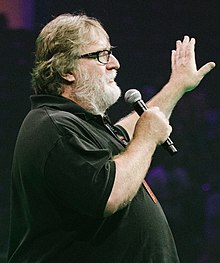Portal:Video games
The Video Games Portal

A video game, also known as a computer game or just a game, is an electronic game that involves interaction with a user interface or input device (such as a joystick, controller, keyboard, or motion sensing device) to generate visual feedback from a display device, most commonly shown in a video format on a television set, computer monitor, flat-panel display or touchscreen on handheld devices, or a virtual reality headset. Most modern video games are audiovisual, with audio complement delivered through speakers or headphones, and sometimes also with other types of sensory feedback (e.g., haptic technology that provides tactile sensations). Some video games also allow microphone and webcam inputs for in-game chatting and livestreaming.
Video games are typically categorized according to their hardware platform, which traditionally includes arcade video games, console games, and computer (PC) games; the latter also encompasses LAN games, online games, and browser games. More recently, the video game industry has expanded onto mobile gaming through mobile devices (such as smartphones and tablet computers), virtual and augmented reality systems, and remote cloud gaming. Video games are also classified into a wide range of genres based on their style of gameplay and target audience. (Full article...)
Featured articles –
Development of Riven began soon after Myst became a success, and spanned more than three years. In an effort to create a visual style distinct from that of Myst, director Robyn Miller and his brother, producer Rand Miller, recruited former Aladdin production designer Richard Vander Wende as a co-director. Broderbund employed a multimillion-dollar advertising campaign to publicize the game's release.
Riven was praised by reviewers, with the magazine Salon proclaiming that the game approaches the level of art. Critics positively noted the puzzles and immersive experience of the gameplay, though publications such as Edge felt that the nature of point-and-click gameplay limited the title heavily. The best-selling game of 1997, Riven sold 1.5 million copies in one year. After the game's release, Robyn Miller left Cyan to form his own development studio, ending the professional partnership of the two brothers. Rand stayed at Cyan and continued to work on Myst-related products including The Myst Reader and the real-time rendered game Uru: Ages Beyond Myst. The next entry in the Myst series, Myst III: Exile, was developed by Presto Studios and published by Ubisoft. A remake of the game, recreating the world in fully explorable 3D and supporting both normal and virtual reality, was released in June 2024. (Full article...)
Designed by an R&D team supervised by Hideki Sato and Masami Ishikawa, the Genesis was adapted from Sega's System 16 arcade board, centered on a Motorola 68000 processor as the CPU, a Zilog Z80 as a sound controller, and a video system supporting hardware sprites, tiles, and scrolling. It plays a library of more than 900 games on ROM-based cartridges. Several add-ons were released, including a Power Base Converter to play Master System games. It was released in several different versions, some created by third parties. Sega created two network services to support the Genesis: Sega Meganet and Sega Channel.
In Japan, the Mega Drive fared poorly against its two main competitors, Nintendo's Super Famicom and NEC's PC Engine, but it achieved considerable success in North America, Brazil, and Europe. Contributing to its success was its library of arcade game ports, the popularity of Sega's Sonic the Hedgehog series, several popular sports franchises, and aggressive youth marketing that positioned it as the cool console for adolescents. The 1991 North American release of the Super Nintendo Entertainment System triggered a fierce battle for market share in the United States and Europe known as the "console war". This drew attention to the video game industry, and the Genesis and several of its games attracted legal scrutiny on matters involving reverse engineering and video game violence. Controversy surrounding violent games such as Night Trap and Mortal Kombat led Sega to create the Videogame Rating Council, a predecessor to the Entertainment Software Rating Board. (Full article...)
The story follows bounty hunter Samus Aran after she is sent to rescue Galactic Federation Marines from a ship near Aether, a planet inhabited by a race known as the Luminoth. She discovers that the troops were slaughtered by the Ing, a hostile race that came from an alternate dimension of Aether. Samus must travel to four temples to ensure the destruction of the evil Ing, while battling them, wild creatures, Space Pirates, and her mysterious doppelgänger Dark Samus.
Retro sought to differentiate Echoes with a heavier focus on story-telling and new gameplay mechanics. Nintendo launched a viral marketing campaign that included several websites written as if taking place in the Metroid universe. The single-player mode was acclaimed for its graphics, atmosphere and music, though its steep difficulty and multiplayer mode were met less positively. (Full article...)
Independent video game developer Nicalis worked with Amaya to port the game to WiiWare and DSiWare in 2010. An enhanced version, Cave Story+, was released for Steam in November 2011, and the original game was released for the Nintendo 3DS in October 2012 with added content. A 3D remake of the game, titled Cave Story 3D, was developed by Nicalis and published by NIS America for the Nintendo 3DS in November 2011. A port of Cave Story+ for the Nintendo Switch was released in June 2017.
Cave Story revolves around Quote, a robot who wakes up suffering from amnesia and explores in diverse cavernous areas in order to uncover his backstory and escape from the cave. The character gains access to new areas as he powers up his weapons by collecting triangular experience crystals and solves various platforming puzzles. Quote speaks to non-player characters scattered around the game world in order to learn more about the world and its inhabitants. (Full article...)
343 Industries, an internal studio established by Microsoft in 2007, was given control over the Halo franchise after the release of Bungie's final entry, Halo: Reach in 2010. 343 Industries approached Saber Interactive to develop a remaster of Combat Evolved for the game's tenth anniversary. Saber used its proprietary game engine to reproduce the graphics and the original Halo engine for gameplay. A development tool for toggling between the old and new visuals for comparison became a feature in the shipping game. Anniversary's enhancements include a complete high-definition visual overhaul, support for cooperative and multiplayer gameplay via the Xbox Live online service, new and remastered sound effects and music, and extras such as achievements, in-game collectibles, and Kinect support.
Critical reception to Anniversary was generally positive. The updated graphics, sounds, and ability to toggle between the remastered and original visuals were praised. Complaints included technical glitches, faults with the original game's level design, and the multiplayer implementation. (Full article...)
Melee includes all playable characters from the first game and also adds characters from additional franchises such as Fire Emblem, of which no games had been released outside Japan at the time, in addition to new stages and gameplay modes. Like other games in the Smash Bros. series, Melee's gameplay system offers an unorthodox approach to the fighting game genre, with a counter that measures damage with increasing percentages, representing the knockback the character will experience, rather than a depleting health bar seen in most fighting games.
Melee was first released in Japan in November 2001, in the Americas in December 2001, and in Europe and Australia in May 2002. The game received widespread acclaim from critics, earning praise for its visuals, simple controls, gameplay, and orchestrated soundtrack, as well as several awards and acknowledgments from various publications; it is now considered one of the greatest video games ever made. It achieved strong sales upon its release, becoming the GameCube's best-selling title, with over seven million copies sold by 2008. Considered one of the most competitively viable Smash Bros. games due to its fast-paced and aggressive gameplay, Melee has been featured in many competitive gaming tournaments, boasting a dedicated grassroots fan community which has kept its competitive scene alive well beyond the game's original lifespan. It was followed by Super Smash Bros. Brawl for the Wii in 2008. (Full article...)
The original Master System models use both cartridges and a credit card-sized format known as Sega Cards. Accessories include a light gun and 3D glasses that work with specially designed games. The later Master System II redesign removed the card slot, turning it into a strictly cartridge-only system, and is incompatible with the 3D glasses.
The Master System was released in competition with the Nintendo Entertainment System (NES). Its library is smaller and with fewer well-reviewed games than the NES, due in part to Nintendo licensing policies requiring platform exclusivity. Though the Master System had newer, improved hardware, it failed to overturn Nintendo's significant market share advantage in Japan and North America. However, it attained significantly greater success in other markets, including Europe, Brazil, South Korea and Australia. (Full article...)
Underground is built upon the skateboarding formula of previous Tony Hawk's games: the player explores levels and completes goals while performing tricks. It features a new focus on customization; the player, instead of selecting a professional skater, creates a custom character. Underground adds the ability for players to dismount their boards and explore on foot. The plot follows the player character and their friend Eric Sparrow as the two become professionals and grow apart.
Underground was developed with a theme of individuality which was manifested in the extensive character customization options, the presence of a narrative, and the product's characterization as an adventure game. Real world professional skateboarders contributed their experiences to the plot. Underground was a major critical and commercial success, with reviewers praising its wide appeal, soundtrack, customization, multiplayer, and storyline. The graphics and the controls for driving vehicles and walking were less well received. Underground's PlayStation 2 version had sold 2.11 million copies in the United States by December 2007. A sequel, Tony Hawk's Underground 2, followed in 2004. (Full article...)
Did you know... -
- ... that the name of the video game mod series Bomba Patch was inspired by éclairs?
- ... that the character Psycho Mantis in the video game Metal Gear Solid breaks the fourth wall by identifying the player's other games?
- ... that the web-based video game Moderator Mayhem was based on a card game meant to demonstrate the difficulties of content moderation?
- ... that Rockstar Vienna was the largest video game developer in Austria when it closed in 2006?
- ... that the album series Jingle Cats spawned Jingle Dogs, Jingle Babies, and a Japanese video game in which "the object is to breed and care for cats, which begin to sing when they're done copulating"?
- ... that the video game JFK Reloaded recreates the assassination of John F. Kennedy from the perspective of the killer?
- ... that MicroProse was formed to publish Hellcat Ace after Sid Meier boasted that he could design a better video game than Red Baron in a week?
- ... that the 1999 video game Interplay Sports Baseball Edition 2000 used a public-address announcer while its rivals were switching to two commentators as featured on real MLB game broadcasts?
- ... that LittleBigPlanet, a video game that allows the player to create levels, coincided with the rise of user-generated content?
- ... that the success of Kingdom Rush prompted plans to grow the video game industry of Uruguay?
- ... that the illustrations in the 1992 video game Tetris Classic are based on scenes from Alexander Pushkin's poem Ruslan and Ludmila?
- ... that the video game Fursan al-Aqsa received an update that allows players to reenact the October 7 attacks on Israel?
Selected biography –
Selected image -
Recent video game-related events
- September 12, 2024 – 2023–2024 video game industry layoffs
- Microsoft announces that it will lay off 650 Microsoft Gaming employees as part of cuts to its workforce. (Variety)
- August 15, 2024 –
- American video game magazine Game Informer discontinues publication after 33 years. The magazine's website is also shut down. (BBC News)
- May 24, 2024 – Uvalde school shooting
- Families in Uvalde, Texas, U.S., file a lawsuit against Daniel Defense and Activision Blizzard for creating the DDM4 V7 gun and promoting the weapon through the game Call of Duty, respectively. They also sue Meta Platforms for owning Instagram, which was used by the gunman. (AP)
Topics
Categories
Things you can do
In other Wikimedia projects
The following Wikimedia Foundation sister projects provide more on this subject:
-
Commons
Free media repository -
Wikibooks
Free textbooks and manuals -
Wikidata
Free knowledge base -
Wikinews
Free-content news -
Wikiquote
Collection of quotations -
Wikisource
Free-content library -
Wikiversity
Free learning tools -
Wiktionary
Dictionary and thesaurus













































